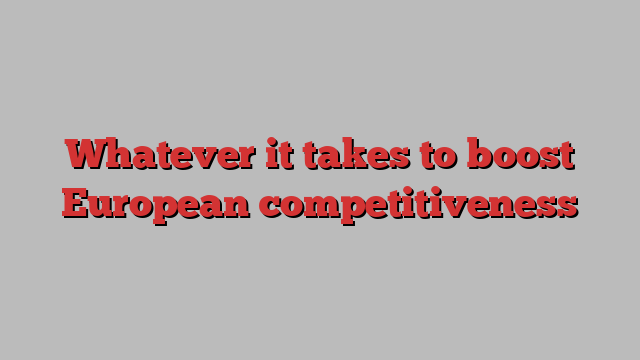
Unlock the Editor’s Digest for free
Roula Khalaf, Editor of the FT, selects her favourite stories in this weekly newsletter.
With his three-word promise to do “whatever it takes”, former European Central Bank president Mario Draghi is said to have forestalled the eurozone’s sovereign debt crisis in 2012. At 400 pages, his solution to raising the EU’s flagging economic competitiveness is a great deal more wordy. But the overall principle, of doing whatever it takes, is similar. The bloc, he argues, needs a “new industrial strategy”, and must raise investment by €800bn a year to boost its growth. At 4.7 per cent of GDP, that is over double the scale of the Marshall Plan, relative to the size of the economy.
Draghi is right about the scale of the challenge. The bloc needs an ambitious agenda to jump-start its long subdued productivity growth. The economy has persistently grown more slowly than the US over the past two decades.
It has also become clearer that Europe’s economic model is in urgent need of renewal. The US is spending heavily to attract clean technology industries. Imports of cheap green tech from China have also sparked fears of deindustrialisation, particularly in Germany, the EU’s largest economy. Last week, the finance chief of Volkswagen, Europe’s largest carmaker, warned that the company had “a year, maybe two” to adapt to lower sales. The ongoing trade war with China and the possibility of a second, more protectionist, Donald Trump presidency also threatens its exports.
Draghi blames the bloc’s failure to leverage its vast single market for many of its economic woes. Indeed, Europe could unlock trillions of euros in deep, liquid pools of financing for investment and business growth if its hodgepodge of exchanges, clearing houses and national securities laws were combined. As the Financial Times reported on Monday, European productivity is also stifled by excessive form-filling and varying regulatory requirements. Alleviating existing trade frictions between member states could also support the EU’s economic growth.
The report makes a number of sensible, if not new, recommendations to help Europe capture digital and green growth opportunities. This includes integrating capital markets by centralising market supervision, developing new common funding pots, and aligning and streamlining industrial, competition and trade regulations. A broader push for closer co-operation on energy, innovation and national security is also welcome.
Draghi’s recommendations give newly re-elected European Commission president Ursula von der Leyen — who commissioned the report — a valuable framework for a new term. But acting on them will be the real challenge. First, the bloc’s two largest economies, France and Germany, are grappling with unstable coalition governments that may hinder any progress on EU-wide matters. Second, strategic co-operation is easier said than done. Frugal northern European countries are still cautious about raising spending or issuing common debt. Plans for a capital market union have long been frustrated by domestic interests.
Von der Leyen needs to build a team of competent policymakers. Trimming regulation and clearly defining areas for strategic co-operation is tricky business. A recommendation by Draghi for European merger rules to consider industrial strategy objectives has already raised concern that it could undermine internal market competition.
Europe has proven it can adapt under pressure. It has weaned itself off Russian gas and cobbled together €750bn for its post-pandemic recovery package. The threats then were soaring energy prices and an economic crunch. Weakening competitiveness may feel less impending, but it is no less important. The further Europe falls behind, the harder it will be to catch up. Draghi’s timely report should focus the minds.